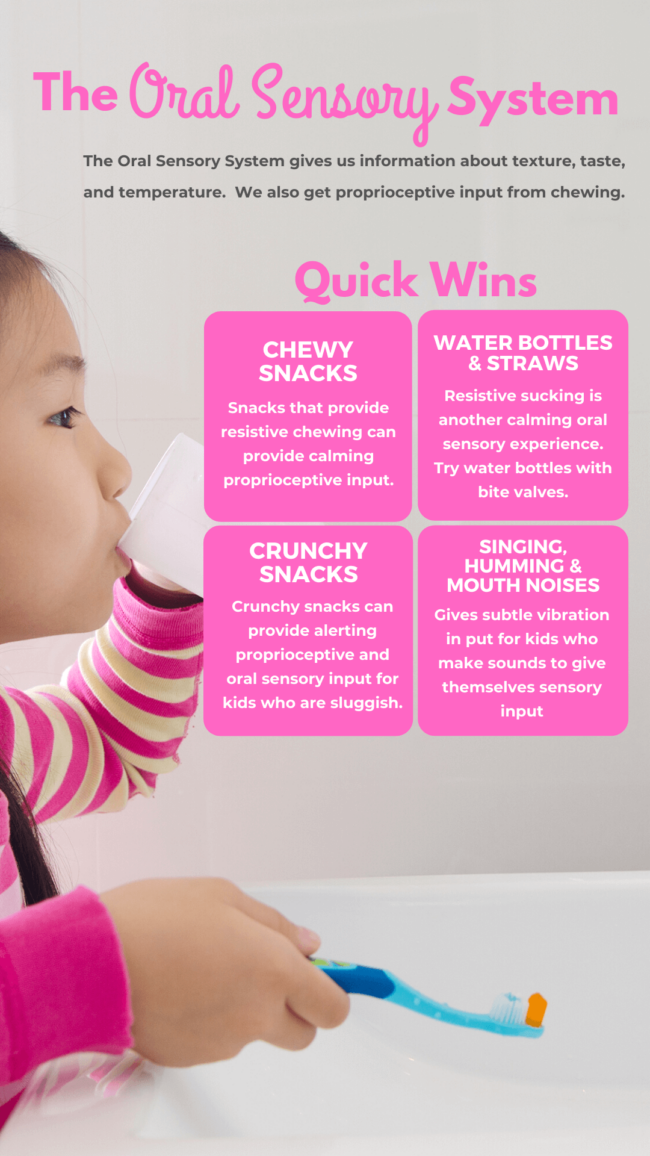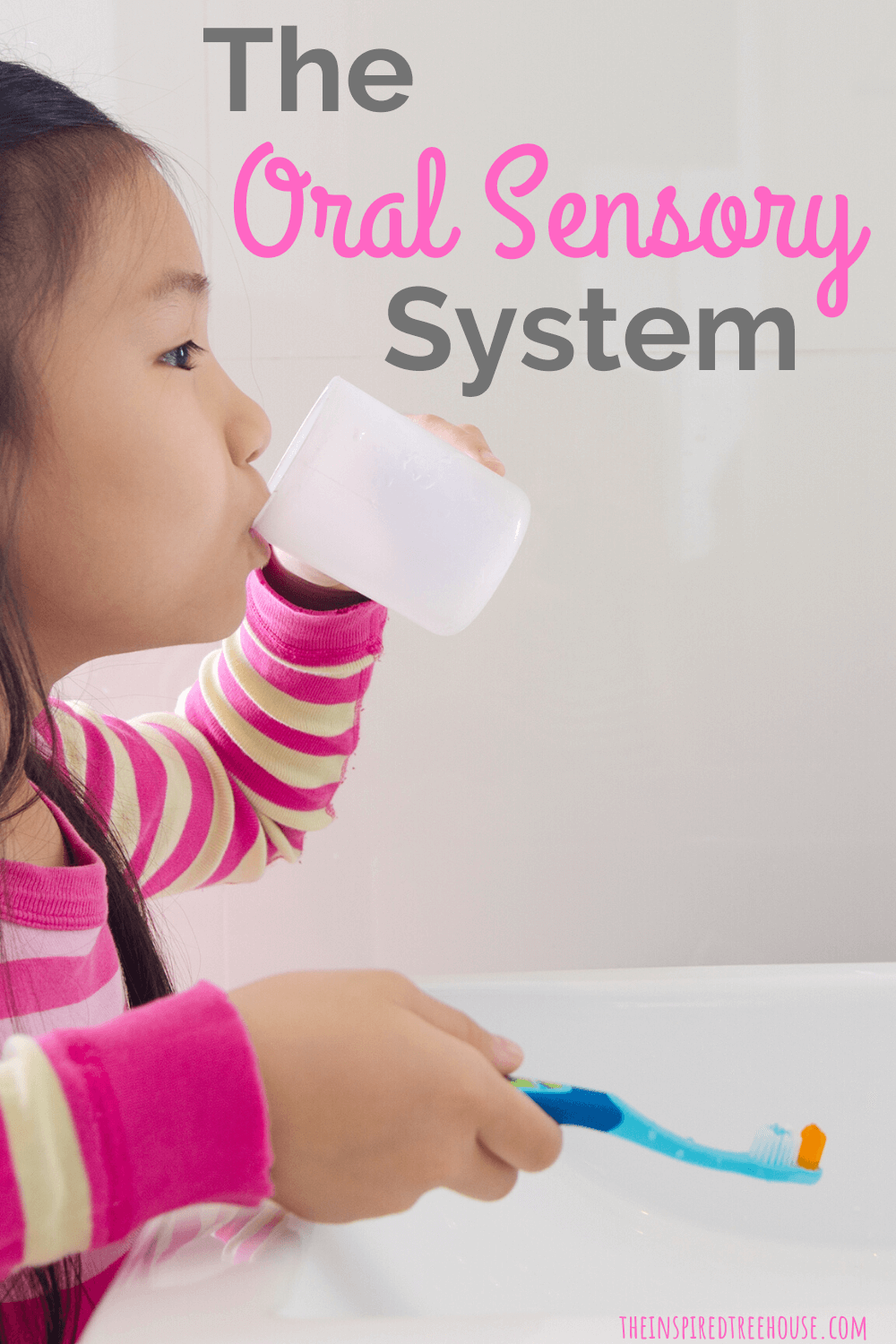What can you do about kids who chew on everything? How can you use the oral sensory system to help promote calm behavior or to help increase alertness? What does oral sensory even mean?
What does oral sensory mean?
We’ve described how the ears, the skin, the eyes, and the muscles and joints channel information about kids’ surroundings to their brains where it can be processed and understood. But what about the mouth?
The sensory receptors in our mouths allow us to perceive temperature, texture (e.g. smooth like yogurt, hard like a potato chip, or a mixture of textures like cereal with milk), and taste (e.g. sweet, salty, bitter, sour). Our brains also receive lots of proprioceptive information from the joint of the jaw as we bite and chew different foods that provide different types of resistance (e.g. a crunchy carrot, a chewy piece of candy).
Oral sensory processing also contributes to the way we move our mouths, control our saliva, and produce sounds for clear speech. The way our mouths perceive sensory information helps us eat and drink in a functional, adaptive way and allows us to enjoy and participate in mealtimes with family and friends.

RISE With Sensory Course
Are you ready to learn powerful sensory strategies to support kids’ sensory needs so they can RISE to their full potential?
Whether you’re a parent or a professional, this course is for you!
The RISE With Sensory Course is This class is AOTA approved for 7 hours (.7 CEU) and is the perfect starting point for new therapists, or refresher for experienced therapists.
Looking for a streamlined approach for working with kids with sensory concerns and for communicating clearly with parents and caregivers about sensory processing?
Click here to learn more!
Healthy Oral Sensory Processing
Children with healthy oral sensory systems typically eat a variety of foods with a range of tastes and textures. They are willing to try new foods (within reason…it is common for young kids to avoid certain foods like green leafy vegetables and certain kinds of meat).
Kids with healthy oral sensory systems can tolerate eating foods with mixed textures like cereal and milk or vegetable soup and are able to tolerate tooth brushing and visits to the dentist with minimal protest. A child with a healthy oral sensory system does not need to seek out additional oral sensory experiences (e.g. chewing) in order to regulate his behavior.
Problems With Oral Sensory Processing
Some children struggle with processing and responding to the oral sensory information they encounter in everyday life. They may have a heightened sensitivity (hypersensitivity or defensiveness) to oral input, causing them to be resistant to oral sensory experiences like trying new foods or brushing their teeth. They may choke or gag during these experiences.
These children are often described as “picky eaters” and may have an extremely limited diet, restricting themselves to only a few familiar foods. Children with oral sensory processing issues may also refuse to use utensils to eat, disliking the feeling of a spoon or fork in their mouths.
Their resistance to oral sensory experiences can be accompanied by extreme emotional reactions (e.g. tantrums, fear, running away), making mealtimes and dental hygiene very difficult. These children may be referred to specialized feeding clinics for aversions and to expand their diets and tolerances.
Other children experience decreased sensitivity to oral sensory input (hyposensitivity). These children may require more oral sensory input in order to help them organize their behavior and pay attention.
They may bite, chew on, or mouth non-food objects (clothing, hands, fingers, pencils, toys) and even try to bite others. These children may require the use of chewy toys to prevent this type of behavior. They may make lots of noise with their mouths for extra sensory input (clicking, humming, buzzing), to the point of annoying or distracting the people around them.
Sometimes children who are seeking out more oral sensory input will stuff their mouths with food at mealtimes. Decreased sensitivity to oral input can also lead to difficulty with awareness of the movements of the mouth, including coordinating the movements needed for chewing effectively and drinking from a cup or a straw. It may affect oral motor planning and sound and speech production.
Our Favorite Oral Sensory Suggestions and Activities for Kids
Oral sensory input can affect a child’s levels of arousal and potentially even change behaviors, helping a child become more organized and responsive.
Alerting Oral Sensory Activities
Alerting oral sensory activities can bring more awareness and provide the sensory input kids need to focus and attend better at home and at school. Some examples of alerting oral sensory activities include:
-Vibration (battery powered toothbrush, vibrating toys on cheeks/lips)
-Play with mouth noises: buzzing like a bee, clicking tongue, humming, blowing raspberries
-Play with making faces in a handheld mirror or imitating others’ funny faces: open mouth wide, sticking tongue out, smiling, frowning, filling cheeks up with air
-Eating crunchy snacks (e.g. apples, chips, pretzels, popcorn, raw veggies, toast, graham crackers, granola)
-Eating snacks with sour/sweet tastes (e.g. Warheads, sour gummy worms, grapefruit or orange wedges, lemonade)
-Eating salty snacks (e.g. chips, pretzels, nuts) -Snacking on cold foods (e.g. ice chips, popsicles, frozen grapes)
-Trying snacks with intense tastes and temperatures (Hot Tamales, carbonated beverages)
–Oral sensory snacks
Calming Oral Sensory Activities
Calming oral sensory activities can help to calm the body, helping kids to regulate their behavior and function more appropriately for learning and other daily tasks. Some examples of calming oral sensory activities include:
-Sucking thicker liquids (milk shakes, smoothies, applesauce, pudding) through a straw
-Drinking from a water bottle with a straw or opening that requires sucking
-Drinking from a water bottle with a bite valve
-Resistive chewing
-Gum or chewy candy (Charleston chews, caramel suckers, Starburst, Skittles, gummy bears, licorice)
-Dried fruits, fruit roll ups,, marshmallows, oranges, raisins
-Blowing bubbles, blowing up balloons, or blowing whistles and other instruments
–Calming breathing techniques for kids
-Maintaining a sound for as long as possible (e.g. singing a note for as long as possible with one breath)
-Singing or humming
-Using chewy toys such as products from Chewigem USA
–Oral sensory snacks
Our Favorite Oral Sensory Toys
Chewigem Bracelets
Chewigem Pendants
Ps and Qs
Chewy Wrist Bands
Bite Bands
ARK Krypto Bite XXT
Battery Powered Toothbrush
Chewable Pencil Toppers
Abilitations Jigglers
Whistles
Kazoos
Harmonicas
Camelbak Water Bottles
Party Blowers
Bubbles
Learn more about picky eating and other feeding challenges
How to Help Kids Practice Self-Feeding With Utensils
Oral Sensory Snack Ideas
Tools, Toys & Games to Help Kids With Feeding Challenges
Oral Sensory & Olfactory Strategies for Teens [FREE Printable]
Tips for Picky Eaters
Read up on the rest of the sensory systems
The Proprioceptive System
The Visual System
The Auditory System
The Vestibular System
The Tactile System
What is Interoception?
Sensory Processing Strategies for Teens & Older Kids.


Latest posts by Claire Heffron (see all)
- Cute Zipper Bags for Therapists - April 18, 2024
- Fairy Tale Games and Toys - April 12, 2024
- The Best Emotional Regulation Books for Kids - April 8, 2024


[…] Sensory Processing: What Does Oral Sensory Mean? […]